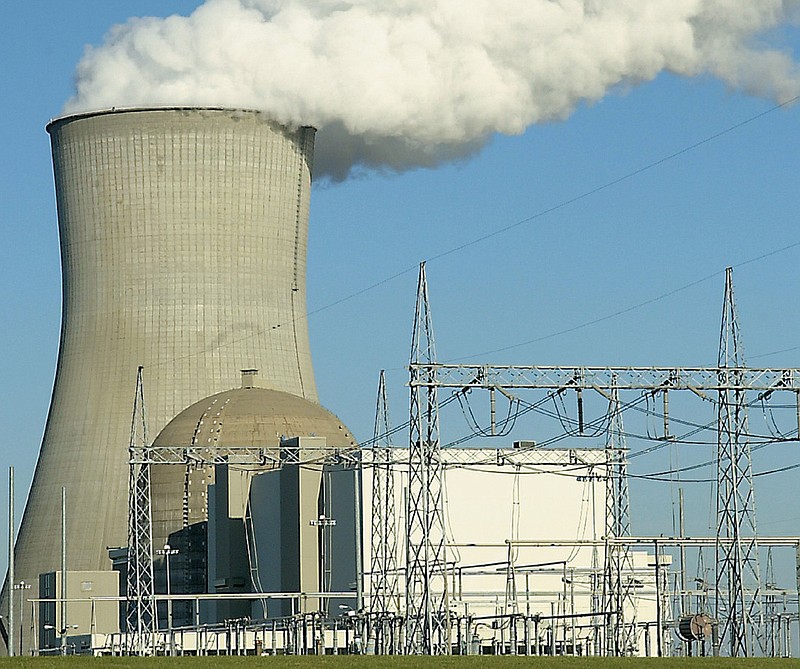The Callaway Energy Center nuclear power plant is having and will have upgrades made to extend its operational life and increase efficiency through the next 24 or 44 years, according to Ameren Missouri officials.
The power plant is also equipped to withstand what nature may throw at it during its lifetime, company officials said.
The Callaway plant is currently licensed to operate through 2044, but Ameren Missouri plans to seek renewal of the license.
The company has included the nuclear power production center as part of its strategy to cut its carbon emissions in half over the next 10 years and have net-zero carbon emissions by 2050.
Stephanie Banker, Ameren Missouri's vice president of nuclear engineering and support, said Monday the license renewal would extend the plant's life to 2064, 44 years from now and 80 years since the plant opened in December 1984.
The plant is currently in its 24th planned refueling and maintenance outage, which happens every 18 months so fuel assemblies in the reactor can be replaced and other upgrades can be made.
Barry Cox, Callaway site vice president, said work underway includes repairs and upgrades, including to the plant's main generator, that will enable the plant to operate through 2044.
With an additional 800 workers brought in for the outage, the company is taking health precautions to protect workers during the COVID-19 pandemic.
The pandemic has caused supply shortages that have affected other aspects of people's daily lives, but Cox said that has not been the case for the power plant; all nuclear fuel was delivered on time and was able to be put into the reactor vessel.
In the decades ahead, Banker said, the company has a fuel strategy for obtaining the needed uranium fuel for the plant that's in place and is monitored by executive staff.
"We buy well ahead of our refuels to ensure that we have adequate uranium contracts in place," she said.
What's also in place is a large portion of the plant's original infrastructure from the 1980s - things such as pipes, pumps and valves.
Cox said there have been upgrades over the years to large features such as steam generators and main electrical transformers, but inspections determine when things such as pipes get replaced.
In the coming years, he expects the plant will become more digitized - instead of using original analog equipment - and that will allow for more precise and efficient control of the systems in the plant, which is a way to keep production cost down.
As the company expands renewable energy options of wind and solar power production and eventually phases out coal-fired power plants as part of its carbon emissions-cutting plan, Cox also said the power system will be able to handle the loads from when Callaway is being refueled - and part of that will be having battery storage technology that will be produced in the future.
As it is, Callaway generates about 25 percent of the energy for Ameren Missouri's 1.2 million customers.
Cox and Banker said the plant is prepared for hazards in the future, be they earthquakes or storms.
The Union of Concerned Scientists this month gave Callaway a one in a 13,800 chance per year an earthquake would cause a nuclear meltdown in its reactor - though not every meltdown would necessarily release significant amounts of radiation that could contaminate surrounding areas, such as what happened in March 2011 in Japan after a magnitude 9.0 earthquake and resulting tsunami damaged the Fukushima Dai-ichi nuclear power plant there.
The Union of Concerned Scientists is a nonprofit science advocacy organization that seeks to combat climate change; promote sustainable energy, transportation and agricultural systems; reduce the threat of nuclear war; and defend the scientific method and democracy.
The organization listed Callaway as the second most vulnerable nuclear reactor site in the U.S. from seismic risks, after the H.B. Robinson plant in South Carolina, and above two other plants in South Carolina and more in Virginia, Michigan, Washington, California, Pennsylvania and Alabama.
UCS also noted the Nuclear Regulatory Commission considers a reactor core damage chance of one in 10,000 per year - from any potential accident - "to be the upper limit for acceptable reactor safety risk."
Banker said Callaway has "invested millions of dollars over the last few years evaluating the robustness of the plant," and it's designed to withstand "a significant seismic event."
Risk analyses have also included high winds, tornadoes and flooding, she said.
At Fukushima in 2011, the earthquake and tsunami cut power to the plant there, leaving reactors without a way to be cooled, so they overheated and melted down.
Cox said Callaway has on-site the equipment it would need to prevent that from happening.
Callaway also has on-site a hardened 500,000-gallon water tank for such emergencies, he said. The tank and a protective netting set up around it are intended to withstand a truck being picked up by a tornado and thrown against the tank without being punctured.

